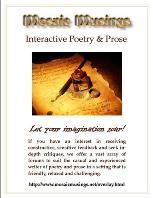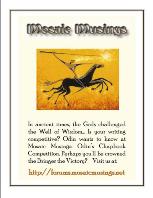 Jun 11 09, 10:57 Jun 11 09, 10:57
Post
#1
|
|
|
Group: Gold Member Posts: 11,811 Joined: 15-June 07 From: Springfield, Louisiana Member No.: 446 Real Name: Larry D. Jennings Writer of: Poetry & Prose Referred By:Just wondered in. |
Focus
Three young men who bred cattle in France Chose a name for their place, not by chance. So as not to confuse, A small pun they did use; Which explained everything at a glance L5 did read: For they felt it explained at a glance ___________________________________________ *footnote removed - If you need an explanation, look at Mark's post! ·······  ······· ·······When power leads man toward arrogance, poetry reminds him of his limitations. When power narrows the areas of man's concern, poetry reminds him of the richness and diversity of his existence. When power corrupts, poetry cleanses.
John Fitzgerald Kennedy Kindness is a seed sown by the gentlest hand, growing care's flowers. Larry D. Jennings MM Award Winner    |
|
|
|
 |
Replies
 Jun 11 09, 17:49 Jun 11 09, 17:49
Post
#2
|
|
|
Group: Gold Member Posts: 698 Joined: 29-May 06 From: US East Coast Member No.: 185 Real Name: Peggy Harwood Writer of: Poetry & Prose Referred By:just wandered in |
Hi Larry,
I'm afraid this is too complex for me! I believe poems should be able to stand on their own without footnotes. This doesn't seem clear enough without the footnote. Also, the two short lines are 6 syllables each. I'm almost positive a limerick should be 9 9 5 5 9 I've taken the liberty of shortening the needed lines by 1 syllable each and changed "chance" to "romance." Focus ( Your version) Three young men who bred cattle in France Chose a name for their place, not by chance. So as not to confuse, A small pun they did use; For they felt it explained at a glance Focus (My suggested version) Three young men who bred cattle in France Chose a name for their place, not by chance. So not to confuse, 5 A small pun they used, 5 For they felt it explained cow romance. (Thought you might consider "romance.") Of course you're the poet, so use or lose. Peggy ·······  ······· ······· |
|
|
|
 Jun 11 09, 19:42 Jun 11 09, 19:42
Post
#3
|
|
|
Assyrian   Posts: 201 Joined: 28-April 09 From: Canada Member No.: 784 Real Name: Marc-Andre Germain Writer of: Poetry |
Peggy,
In accentual-syllabic poetry, we count by metrical feet rather than by syllables only. The limerick starts with two anapestic trimeters, i.e three feet of a-na-PEST, two anapestic dimeters, i.e. two feet of a-na-PEST and ends with an anapestic trimeter. The pattern is thus xxX/xxX/xxX/ xxX/xxX/xxX/ xxX/xxX/ xxX/xxX/ xxX/xxX/xxX/ That said, iambic substitutions ( i-AMB) are common, especially in the initial foot, and sometimes in the dimeter lines. Your version would still be acceptable, but Larry's is purest in form. There are three main metrical systems: - syllabic: counts the number of syllables, that is the system used in unstressed languages, like French; - accentual: counts the stressed beats regardless of syllable count; - accentual-syllabic: the formal English meter, metrical feet composed of stressed and unstressed beats. The four commonest ones are the iamb ( xX ), the trochee ( Xx ), the anapest ( xxX ) and the dactyl ( Xxx ). Then you count the number of feet per line to get: monometer, dimeter, trimeter, tetrameter, pentameter, hexameter, heptameter ( this line length is known as "fourteeners") and octometer. If this is still confusing, let me know and I'll come back with clear examples for each. I hope this helps, Mark ·······  ······· ······· |
|
|
|
Posts in this topic
 Larry Focus Jun 11 09, 10:57
Larry Focus Jun 11 09, 10:57 
 Marc-Andre Germain Larry,
I'm afraid that this didn't make i... Jun 11 09, 11:49
Marc-Andre Germain Larry,
I'm afraid that this didn't make i... Jun 11 09, 11:49 
 Larry Hi Mark,
Yes, I know it is a Limerick and not a H... Jun 11 09, 15:02
Larry Hi Mark,
Yes, I know it is a Limerick and not a H... Jun 11 09, 15:02 
 Peggy Carpenter Harwood Hi,
Thanks for the review!!! Sometim... Jun 11 09, 19:54
Peggy Carpenter Harwood Hi,
Thanks for the review!!! Sometim... Jun 11 09, 19:54 
 Larry Hello Peggy & Hi again Mark,
Peggy, I appreci... Jun 12 09, 00:53
Larry Hello Peggy & Hi again Mark,
Peggy, I appreci... Jun 12 09, 00:53 

 Marc-Andre Germain Peggy, I love Shakespeare, I think we'll have ... Jun 12 09, 04:49
Marc-Andre Germain Peggy, I love Shakespeare, I think we'll have ... Jun 12 09, 04:49 
 Cleo_Serapis Hi Larry et al,
I tend to favor Accentual-syllabi... Jun 12 09, 07:52
Cleo_Serapis Hi Larry et al,
I tend to favor Accentual-syllabi... Jun 12 09, 07:52 
 Larry Hi Lori,
QUOTE Larry, what a fun limerick! I... Jun 12 09, 10:28
Larry Hi Lori,
QUOTE Larry, what a fun limerick! I... Jun 12 09, 10:28 
 Peggy Carpenter Harwood Hi Larry,
Finally I get the puns! I think yo... Jun 12 09, 11:55
Peggy Carpenter Harwood Hi Larry,
Finally I get the puns! I think yo... Jun 12 09, 11:55 1 User(s) are reading this topic (1 Guests and 0 Anonymous Users)
0 Members:
  |

|
Lo-Fi Version | Time is now: 15th October 2025 - 11:57 |




















